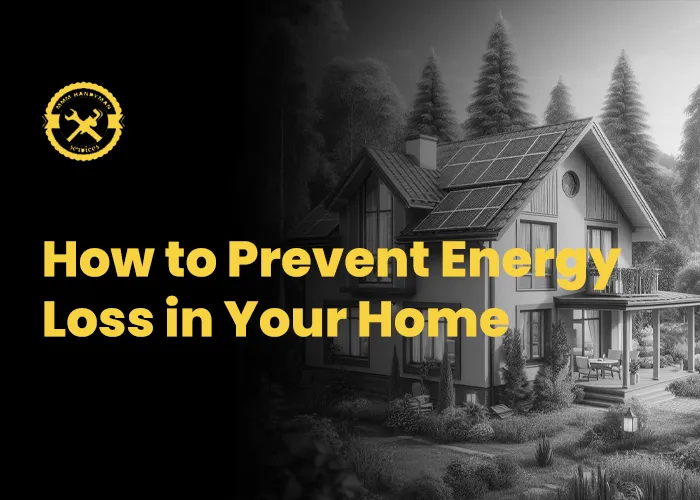
How to Prevent Energy Loss in Your Home: Practical Tips for Maximum Efficiency
Energy loss in your home doesn’t just drive up utility bills; it also puts unnecessary strain on resources and reduces comfort. Taking proactive steps to prevent energy loss ensures your home remains cozy while being environmentally and financially efficient. Whether you’re building a new home or improving an older one, here’s a comprehensive guide on how to prevent energy loss effectively.
Table of Contents
Why Preventing Energy Loss Matters
Energy loss occurs when heat escapes in winter or when cooled air seeps out in summer, forcing your heating and cooling systems to work harder. This inefficiency leads to:
- Higher Energy Costs: A leaky home wastes energy, inflating utility bills.
- Inconsistent Comfort: Drafts and uneven temperatures make your living spaces less enjoyable.
- Environmental Impact: Wasting energy contributes to higher carbon emissions.
By addressing energy loss, you not only save money but also create a sustainable and comfortable home.
Common Sources of Energy Loss
Understanding where energy loss occurs is the first step to tackling the issue. Major culprits include:
- Windows and Doors: Poorly sealed windows and doors allow drafts to enter and conditioned air to escape.
- Insulation Gaps: Inadequate insulation in walls, roofs, and floors reduces thermal efficiency.
- Air Leaks: Cracks, gaps, and openings around vents, pipes, and electrical outlets contribute to energy loss.
- Heating and Cooling Systems: Inefficient HVAC systems or ductwork can leak energy.
- Lighting and Appliances: Older appliances and incandescent bulbs consume excessive energy.
Steps to Prevent Energy Loss in Your Home
1. Seal Air Leaks
Unsealed cracks and gaps are primary contributors to energy loss. Take these measures to address them:
Use caulk to seal gaps around windows, doors, and frames.
Apply weatherstripping to door frames and window sashes to block drafts.
Use spray foam insulation around pipes, vents, and electrical outlets to prevent air leakage.
Regularly inspect these areas, especially during seasonal changes when drafts are more noticeable.
2. Improve Insulation
Insulation is a key barrier against energy loss. Check and upgrade insulation in these areas:
Attic: Add or replace insulation to maintain a consistent indoor temperature.
Walls: Blown-in or foam insulation can fill gaps and boost thermal efficiency.
Floors and Basements: Insulating these areas prevents heat from escaping downward.
The R-value of insulation (its thermal resistance) varies by climate. Consult a professional to ensure your insulation meets regional standards.
3. Upgrade Windows and Doors
Windows and doors are notorious for letting energy escape. Consider these improvements:
Double or Triple Glazing: Replace single-pane windows with energy-efficient double or triple-pane glass.
Low-E Coatings: Install windows with low-emissivity coatings to reduce heat transfer.
Storm Doors: Adding storm doors provides an extra layer of insulation.
Use thermal curtains or blinds to reduce heat loss through glass surfaces.
4. Maintain HVAC Systems
Heating, ventilation, and air conditioning systems are vital to home comfort but can waste energy if not properly maintained.
Service Regularly: Have your HVAC system inspected and cleaned annually.
Replace Filters: Dirty air filters force systems to work harder; replace them every 1–3 months.
Seal Ductwork: Leaky ducts lose conditioned air; seal them with mastic or foil tape.
Upgrade Systems: Consider replacing old units with Energy Star-rated models for better efficiency.
5. Use Energy-Efficient Lighting and Appliances
Outdated lighting and appliances are hidden sources of energy loss. To address this:
Replace incandescent bulbs with LED or CFL bulbs, which use significantly less energy.
Unplug appliances when not in use, or use power strips to eliminate standby power consumption.
Choose Energy Star-rated appliances for long-term savings on electricity and water usage.
6. Install a Smart Thermostat
A smart thermostat helps regulate indoor temperatures more effectively.
Programmable Settings: Adjust temperatures automatically based on your schedule.
Energy Monitoring: Track your energy usage in real time and identify areas for improvement.
Remote Access: Control your thermostat from your smartphone to optimize efficiency.
7. Reduce Heat Loss in the Water System
Water heating accounts for a significant portion of household energy use. Take these steps to minimize heat loss:
Insulate Water Pipes: Use foam pipe sleeves to keep water warmer for longer.
Lower Water Heater Temperature: Set it to 120°F (49°C) to reduce energy use without compromising comfort.
Upgrade to a Tankless Water Heater: These systems heat water on demand, reducing standby energy loss.
8. Harness Renewable Energy
Incorporating renewable energy solutions not only prevents energy loss but also reduces dependency on non-renewable sources. Consider installing:
Solar Panels: Generate clean energy to power your home.
Solar Water Heaters: Heat water efficiently using solar energy.
Monitoring and Maintenance
Preventing energy loss isn’t a one-time effort. Regularly monitoring and maintaining your home ensures long-term efficiency:
- Conduct seasonal energy audits to identify new areas of energy loss.
- Replace or repair damaged seals, insulation, or appliances as needed.
- Stay informed about new energy-saving technologies and incorporate them into your home.
The Cost-Benefit of Energy Efficiency
While some measures require upfront investment, preventing energy loss pays off in:
- Lower Utility Bills: Save hundreds annually by reducing wasted energy.
- Increased Comfort: Enjoy consistent temperatures and fewer drafts.
- Higher Home Value: Energy-efficient homes are attractive to buyers and renters.
Preventing energy loss is essential for maintaining a comfortable, cost-effective, and environmentally friendly home. By sealing leaks, upgrading insulation, maintaining HVAC systems, and embracing efficient technologies, you can minimize energy waste and enjoy the benefits of a well-sealed and energy-efficient home. Take action today to save money, reduce your carbon footprint, and make your home a haven of efficiency.

